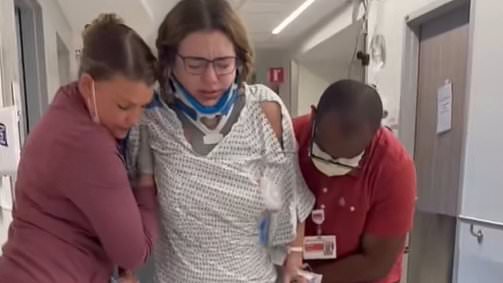Share this @internewscast.com

A young woman with a rare brain disorder has accused medics of ‘handcuffing’ and restraining her without her consent following a major life-saving operation to repair damage to her skull.
Kaitlyn Jenkins, 21, from Texas in the US, has shared a video clip (below) of the terrifying moment she woke up from the procedure, during which medics were forced to restrain her hands to stop her pulling out a breathing tube.
Attached to a ventilator, she was also unable to move or speak.
‘I was absolutely terrified — it felt like I was trapped in a living nightmare,’ she told People magazine.
‘I couldn’t understand why I couldn’t talk, and not knowing what was happening made everything feel even more surreal.’
She explained that, during a pre-operation consultation, the anesthesiologist had ‘quickly mentioned’ she may wake up with a ventilator, but ‘didn’t go into detail’ or mention the handcuffs.
‘It was exhausting and felt like no one fully understood how scared I was,’ she said.
‘I wish the hospital had a better system for patients to communicate when they’re on a ventilator and restrained — because in those moments, not being able to express myself made an already terrifying experience even harder to endure.’
Unable to communicate, she resorted to tracing letters on her mother’s hand to deliver basic requests.
The beauty entrepreneur suffers three disorders that affect her brain and spine, and regularly shares video clips about her physical struggles to her TikTok channel.
These include chiari malformation type 1 —whereby part of the brain bulges through a gap in the back of the skull — craniocervical instability, where the ligaments that hold the head up are too loose, and the connective disorder Ehlers-Danlos Syndrome (EDS).
The combination of illnesses has led to numerous surgeries throughout Ms Jenkins’ lifetime, as well as a constant battle with chronic pain.
Last year, she came across a neurosurgeon in New York who appeared to offer a solution for many of her symptoms — a procedure called craniocervical fusion surgery.
The major operation involves fusing the bones at the junction of the skull and upper skine together using metal plates, rods, and screws.
It aims to increase stability in the area, allowing for freedom of movement and less pain.
While the operation was a success, Ms Jenkins was shocked by the state she woke up in.
None of her previous brain surgeries had involved restraint.
Eventually, she was once again able to breathe without the help of the ventilator, and medics removed the restraints and the breathing tube.
But the emotional impact of the ordeal has left its mark on the young woman.
‘It’s not just a physical recovery; there’s a mental and emotional recovery that takes time, too,’ she said.
‘This experience has definitely changed my perspective on surgery and medical procedures.
‘I’ve always known surgery is serious, but this made me realise how important patient communication is – especially when you’re already facing something as life-altering as brain or spinal surgery.’
Following the surgery, Ms Jenkins spent six weeks in hospital due to complications including osteolysis (the breakdown of bone tissue) and nerve pain — which can cause her to pass out.
‘Re-learning to walk was already challenging, but frequent episodes of passing out made it even harder,’ she said.
By the end of February, she began walking again.
However she still relies on a walking frame to maintain stability and attends physical and occupational therapy three times a week.
She also wears a bone growth stimulator four hours a day, to help the bones grow and fuse together faster.
‘This experience has been physically exhausting and emotionally taxing,’ she said.
‘It’s hard not to think about how things might have been different without the complications, but I try to focus on the progress I am making.’

















